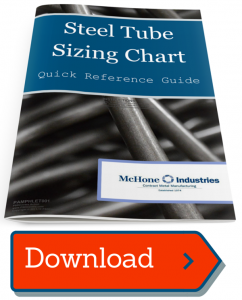
Tubular steel products can be finished in a surprising number of ways. A few weeks ago, we did an article on powder coating for metal tubing. Today, we'll be focusing on common stainless steel finishes.
Here are a few things you should know before we get started. (If you're looking for a broader list of finishing types for all metals, click here.)
1. Metal surface roughness is measured either by Ra (roughness average) or RMS (root mean square) which indicates the difference in the surface's microscopic peaks and valleys.
2. Generally, stainless steel finishes are used to improve the appearance of the metal and reduce surface roughness (reducing Ra and RMS values).
3. Different finishing methods have different textures, patterns, levels of reflectiveness, and effects on the durability of the metal.
The finishing industries identify finishes in a number of different ways. We have categorized each finish with the most common labels.
Mill Finishes
Finishes 1-2BA are known as mill finishes, since they can be performed directly in the tube mill process.
1 or 1D: "As-welded," or hot-rolled, annealed, and passivated. This surface tends to be duller and rougher in appearance than other finishes. The weld seam remains visible. This finish is preferred in non-aesthetic, highly corrosive environments. Common applications include mining, furnace components, refineries, and kiln liners.
2D: Cold-rolled, annealed, pickled, and passivated. This type of finish produces a dull gray finish through pickling, which removes dark spots of chromium. It retains much of the corrosion resistance of 0 and 1. Common applications include chemical equipment, builder's equipment, roofing, and rail car parts.
2B: Cold-rolled, annealed, pickled, and passivated, plus an extra run through highly polished rollers. 2B is a much brighter finish than the first three due to the additional polishing run. It's not as resistant to corrosion, however. Common applications include bakeware, flatware, wheel covers, and laundry equipment.
2BA or 2R: Bright annealed - Oxygen-free annealed tubing is heat treated to reach the desired structural properties. Bright annealing creates a durable, almost mirrorlike finish on the metal. Common applications include heating elements, food processing, and pharmaceuticals.
Hand & Machine Finishes

3 or 2G. Coarse - Fine abrasives are used to create a coarse finish (50-80 grit initially, finished with 100-120 grit). Short polishing lines run the length of the metal due to the higher roughness factors. Roughness typically runs up to 40 Ra. This finish is only slightly reflective. Common applications include kitchen, food processing, and brewery equipment.
4 or 2J. Brushed - Brushed finish is achieved with 120-320 grit abrasives. The finer the grit, the shinier the surface. Roughness runs up to 25 Ra. Common applications include restaurant, hospital, and mass transit equipment.
5. Satin - Satin-style finishes are smooth and lustrous with longer polishing lines. Common applications include architecture, control panels, and catering equipment.
6. The #6 finish is achieved by brushing oil and abrasives onto a #4 finished piece of metal. It is no longer produced in large quantities, though it can still be seen in architecture from the 1930s-'80s.
7 or 2K. Reflective - Not quite mirrorlike, reflective stainless steel is polished with 320 grit and buffed for ten minutes. It will retain some polishing lines which are visible from a short distance. Common applications include wall panels and ornamental trim.
8 or 2P. Mirrorlike - The most reflective finish covered by the ASTM standards, mirrorlike finishing is achieved through 320 grit polishing and twenty minutes of buffing. #7 and #8 have a max roughness of 0.5 Ra. Polishing lines can only be seen from up close. Common applications include mirrors, signage, and press plates.
9. Bead Blast - Bead blasted surfaces are highly uniform and not very reflective. Most commonly, glass or ceramic beads are shot at high speeds to clean and finish the metal.
10. Electropolished or Heat-Colored - This finish is commonly applied to small pieces and parts. It is highly reflective and smooth, due to the anode bath that creates the finish.
Coatings & Other Finishes for Tubular Steel Products

Additional finishes include painting, powder coating, patterning, and non-traditional finishes.
It's rare to see stainless steel coated in any way, since it produces a naturally shiny and attractive finish. Generally, coatings are applied to cheaper, less visually attractive metals like carbon steel. However, you can powder coat, color, spray, or paint stainless steel tubing if you like.
If you want to work outside the box with your steel tubing, there are experts who specialize in decorative non-traditional finishes such as silk screening, acid etching, and other unusual methods.
Patterned stainless steel has its own classification system: 2M (single-sided patterning) and 2W (double-sided patterning). Patterned stainless steel is used in many architectural and public applications. The patterns are naturally low-reflective and do not show small damages and scuffing.
For more information on stainless steel tubing finishes, visit TheFabricator.com, WorldStainless.org, or the Stainless Steel Information Center.


